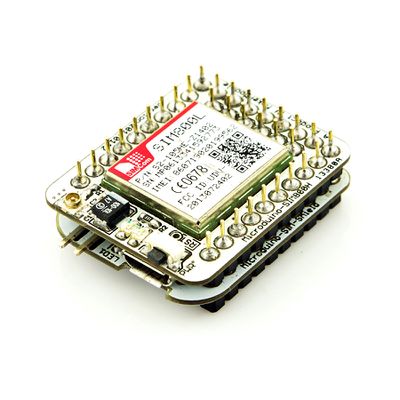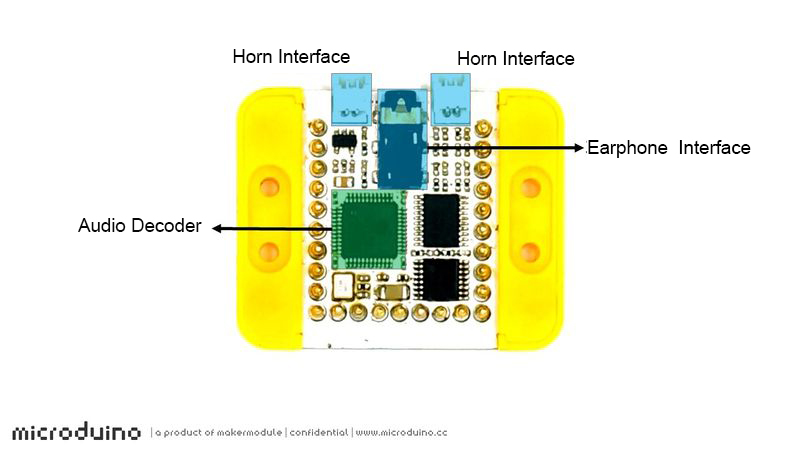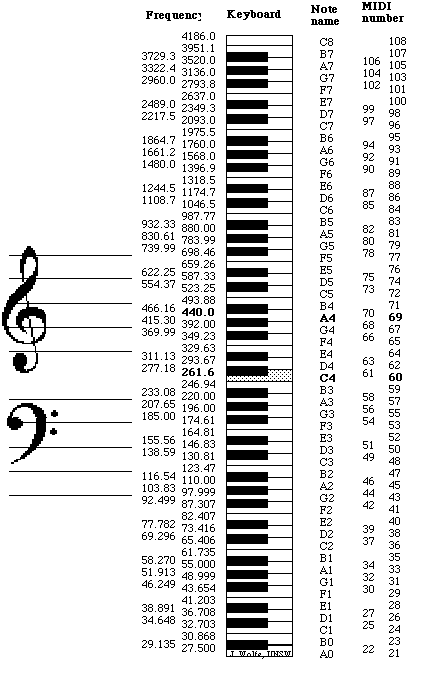|
Microduino AudioPro是以VS1053为解码器,集成2.2W立体声功放,并且支持2.5mm立体声耳机接口的多功能音频模块,支持MIDI功能
特色
- 多种格式的解码支持:MP3/WMA/AAC/WAV/Ogg Vorbis/MIDI
- 可实时模拟多达128种MIDI乐器
- 集成2.2w立体声功放
- 板载2.5mm立体声耳机接口
- 耳机/外放自动切换功能
- SPI高速通信接口
- 小巧、便宜、堆叠、开放;
- 开源的硬件电路设计,与 Arduino 兼容的编程开发环境程;
- 统一的 Microduino 接口规范,和丰富的外围模块,可方便、灵活的与其他符合 Microduino 接口规范的模块、传感器进行快速的连接和扩展;
- 2.54间距的排母接口方便集成到洞洞板。
规格
- 多种格式的解码支持:MP3/WMA/AAC/WAV/Ogg Vorbis/MIDI
- 可实时模拟多达128种MIDI乐器
- 通用的MIDI和SP‐MIDI格式0文件是能播放的,而格式1和2文件必须由用户自己转换成0格式的
- 最多的复音数为64,而最大持续的复音数是40
- 集成2.2w立体声功放(LM4863)
- 板载2.5mm立体声耳机接口
- 耳机/外放自动切换功能
- 18比特超采样率的(oversampling)、多比特的、sigma‐delta型高精度DAC
- 超采样率oversampling一般是指超过标称采样率整倍数的更高采样率,常用来提高采样精度。这里是指还原数码声音时,用标称采样率数倍的采样率输出,可以使音频的阶梯陡变趋于平缓,降低数字背景噪音和减小失真,从而获得超过原采样率输出效果的高质量音频
- 电气特性
- VS1053:3.3V,30~60mA
- LM4863:5V,1A
引脚说明
- D2引脚为实时MIDI接口
- 实时MIDI默认不启用,如需启用,将模块背面的跳线短接即可
- 启用实时MIDI以后,UART的波特率应为31250bps,此时SPI接口将不可用
| AudioPro模块引脚名 |
Microduino引脚 |
功能
|
| SCK |
D13 |
SPI总线时钟
|
| SI |
D12 |
数据输入脚
|
| SO |
D11 |
数据输出脚
|
| CS |
A3 |
SPI片选信 (程序中需要定义)
|
| DCS |
A2 |
数据/命令模式选择 (程序中需要定义)
|
| DERQ |
3 |
中断输出 (程序中需要定义)
|
| MIDI |
2 |
MIDI输入 (默认不启用)
|
文档
开发
- 你可以通过_06_Microduino_AudioPlus_VS1053库进行功能测试:github
- 相关示例程序下载:github
- 其中Audio_MIDI是SPI接口通过加载补丁实现实时MIDI的例程
- 其中Audio_ROM是播放ROM中音频文件的例程
- MIDI的资料见附录
- 音频文件转16进制工具:文件:DataToHex.zip
应用
问题解答
历史
图库
视频
附录
MIDI numbers,Note names and frequencies
可参考:NUSW
- This table is reproduced inverted below, i.e. with high pitch at the top.
- To convert from any frequency to pitch (i.e. to the nearest note and how far it is out of tune, go to the frequency to note converter written by Andrew Botros.
- How to do the caluation? Suppose thattwo notes have frequencies f1 and f2, and a frequency ratio of f2/f1. An octave is a ratio of 2:1, so the number of octaves between f2 and f1 is
- Now to divide the octave into smaller units. In equal temperament, where all semitones have the same frequency ratio of 21/12, conversion between note name and frequency is simple. First, one needs a reference note and frequency. This is usually A4, which is often set at 440 Hz. For a note that lies n semitones higher (or −n semitones lower), the frequency is then
- Conversely, one can obtain n, the number of semitones from A4, from
- Similar equations give no, the number of octaves from A4, and nc, the number of cents from A4:
- no = log2(fn/440 Hz) and nc = 1200*log2(fn/440 Hz).
- In electronic music, pitch is often given by MIDI number: let's call it m for our purposes. m for the note A4 is 69 and increases by one for each equal tempered semitone, so this gives us a simple conversion between frequencies and MIDI numbers (again using 440 Hz as the pitch of A4):
- m = 12*log2(fm/440 Hz) + 69 and fm = 2(m−69)/12(440 Hz).
- The notation used here is not universal: in German speaking countries, H is used instead of B, and B is used for Bb. (This allowed Bach to write his name in the Art of Fugue.) And of course when different tuning systems are used, different names are applied.
MIDI旋律乐器组(GM1)
MIDI打击乐器组(GM1+GM2)
- 27-High Q-电子乐中的按钮声
- 28-Slap-拍打声
- 29-Scratch Push-特效处理推音
- 30-Scratch Pull-特效处理拉(勾)音
- 31-Sticks-鼓棒敲击声
- 32-Square Click-敲方板
- 33-Metronome Click-节拍器击打
- 34-Metronome Bell-节拍器铃声
- 35-Acoustic Bass Drum-原声大鼓(低音大鼓)
- 36-Bass Drum 1-大鼓1(低音鼓)
- 37-Side Stick-敲鼓边
- 38-Acoustic Snare-原声小鼓(军鼓、小鼓)
- 39-Hand Clap-拍手
- 40-Electric Snare-电子小鼓(电子军鼓)
- 41-Low Floor Tom-低音落地筒鼓
- 42-Closed Hi-Hat-闭合踩镲(闭合双面镲)
- 43-High Floor Tom-高音落地筒鼓
- 44-Pedal Hi-Hat-踩镲(踩镲双面镲)
- 45-Low Tom-低音筒鼓
- 46-Open Hi-Hat-开放(双面)镲
- 47-Low-Mid Tom-中低音筒鼓
- 48-Hi-Mid Tom-中高音筒鼓
|
- 49-Crash Cymbal 1-镲击(吊镲)1
- 50-High Tom-高音筒鼓
- 51-Ride Cymbal 1-高架镲1
- 52-Chinese Cymbal-中国镲
- 53-Ride Bell-悬挂钟玲
- 54-Tambourine-铃鼓、小手鼓
- 55-Splash Cymbal-侧击镲、溅开镲声
- 56-Cowbell-牛铃、颈铃
- 57-Crash Cymbal 2-镲击(吊镲)2
- 58-Vibraslap-颤击
- 59-Ride Cymbal 2-高架镲2
- 60-High Bongo-高音邦加鼓
- 61-Low Bongo-低音邦加鼓
- 62-Mute Hi Conga-闷音高音康加鼓
- 63-Open Hi Conga-开放音高音康加鼓
- 64-Low Conga-低音康加鼓
- 65-High Timbale-高音定音鼓
- 66-Low Timbale-低音定音鼓
- 67-High Agogo-高音撞铃(拉丁打铃)
- 68-Low Agogo-低音撞铃(拉丁打铃)
- 69-Cabasa-卡巴沙铃(珠铃)
- 70-Maracas-砂槌(砂铃)
|
- 71-Short Whistle-短口哨
- 72-Long Whistle-长口哨
- 73-Short Guiro-短音刮板(短锯琴、短梗笛)
- 74-Long Guiro-长音刮板(长梗笛)
- 75-Claves-音棒
- 76-Hi Wood Block-高音木鱼
- 77-Low Wood Block-低音木鱼
- 78-Mute Cuica-闷音鸟鸣桶(短笛)
- 79-Open Cuica-开音鸟鸣桶(短笛)
- 80-Mute Triangle-闷音三角铁(三角铃)
- 81-Open Triangle-开音三角铁
- 82-Shaker-摇筛(振动筛)
- 83-Jingle Bell-门铃(信号铃、铃铛)
- 84-Bell Tree-铃树(树铃)
- 85-Castinets
- 86-Mute Surdo-闷音苏多鼓
- 87-Open Surdo-开音苏多鼓
|
|


